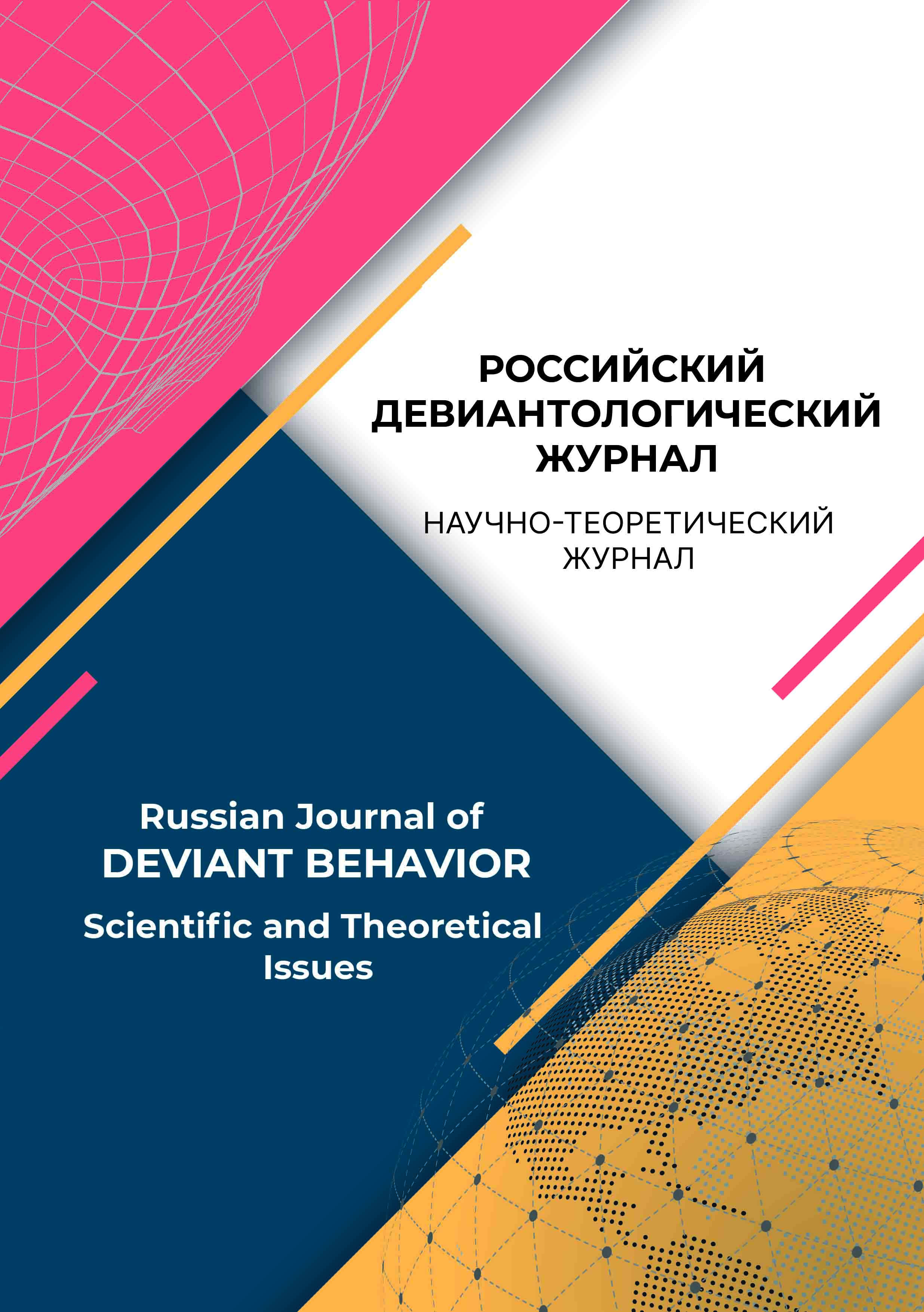Moskva, Russian Federation
Russian Federation
Introduction. The analysis of the suicides committed in 2015-2020 according to the data of the Office of educational, social, and psychological work in the system of Russian Federal Penal Correction Service (FPCS) proves that the rate of suicides in the prison system is still higher than countrywide. The goal of the research is to study the suicides committed by the suspects, accused, and convicted persons. Methods. The research has been based on the analysis of the reviews and other technical materials offered by the FPCS concerning suicide preventions measures among the suspects, accused, and convicted persons in the prison system. Results. The authors have researched the personal characteristics of the suspects, accused, and convicted persons who committed suicides, the circumstances, and conditions of the suicides. To achieve this, the authors analyzed the data gathered in the prison system in case of suspect, accused, and convicted persons suicides (case records, internal review findings), as well as the results of psychological testing of the suspects, accused, and convicted who committed suicides in the Russian prison system in 2020. As a part of the study the authors gathered information on the suspects, accused and convicted persons who committed suicide. The authors have researched a phenomenon of a suicidal behavior of the suspects, accused, and convicted persons. In the theoretical and empirical study, they review both the scientific papers on the suicidal behavior and the FPCS guidelines on prevention of the suicidal behavior of the suspects, accused, and convicted persons. The authors propose measures on preventing of the suicidal behavior of the suspects, accused, and convicted persons. The authors created a profile of the persons committing suicide accounting for their demographic characteristics, their criminal past, and their status in the prison system, considering their psychological status, conditions, and circumstances of the suicide. To form a correlation matrix, the authors have used objective and subjective characteristics of the suspects, accused, and convicted persons who committed suicide. As the result of the correlation analysis, the authors have found a statistically strong connection (r = 0,092; p ≥ 0,05) between the objective and subjective characteristics. Following the founded statistically significant connection, the authors conclude that demographic characteristic and the criminal past of the convicted relate to their suicidal tendencies and may led to the committing of the suicide. The results of the correlation analysis have been used to formulate the recommendations for the suicidal behavior prevention among the convicted persons. The authors have attempted to find a connection between the suicidal behavior and the personal characteristics of the suspects, accused, and convicted persons mentioned in their registry files, and demonstrate the incidence of the certain traits of the suicidal persons. Using content-analysis of the registry files, the authors have chosen the most frequently mentioned personal traits in the psychological profiles of the persons who committed suicides. The interviews with the workers of the FPCS Interregional office of psychological work have shown an additional proof of the hypothesis that the results of the psychological tests correlate with the results of the profile analysis of the suicidal persons and supplement them. The authors have also analyzed the conditions, and circumstances of the suicides, proposed potential directions of the psychological prevention of the suicidal behavior of the suspect, accused, and convicted persons. Practical significance. Implementation of the study findings by the personnel of the prison system in the field of prevention of the suicidal behavior of the suspects, accused, and convicted persons.
penitentiary system, suicides of suspects, suicides of the accused, suicides of convicts, conditions for committing suicides, circumstances for committing suicides, personality traits
1. Ambrumova, A. G., Borodin, S. V., Mihlin, A. S. (1980). Preduprezhdenie samoubijstv. Moskow: Akademiya MVD SSSR.
2. Anan’ev, O. G., Simakova, T. A. (2020). K voprosu o profilaktike suicidal’nogo povedeniya osuzhdennyh, otbyvayushchih nakazaniya v mestah lisheniya svobody. V Yu.A. Mihajlova i dr. (red.), Ugolovno-ispolnitel’naya sistema: realii i perspektivy razvitiya: sbornik materialov II Mezhdunarodnoj nauchno-prakticheskoj konferencii 31 maya 2020 goda (str. 17-22). Pskov: Pskovskij filial Akademii FSIN Rossii.
3. Anisimov, A. G. (2021). Molodezhnye suicidy kak ob”ekt nauchnogo issledovaniya. V A.M. Bychkova, N.V. Keshikova (red.), Problemy sovremennogo zakonodatel’stva Rossii i zarubezhnyh stran: materialy X Mezhdunarodnoj nauchno-prakticheskoj konferencii, g. Irkutsk, 1 oktyabrya 2021 goda (str. 162-167). Irkutsk: Irkutskij institut (filial) VGUYU (RPA Minyusta Rossii).
4. Gizatulina, A. A., Taradanov, A. A. (2017). Logika samoubijstva: monografiya. Chelyabinsk: Izdatel’stvo Chelyabinskogo gosudarstvennogo universiteta.
5. Gilinskij, Ya. I., Smolinskij, L. G. (1988). Sociodinamika samoubijstv. Sociologicheskie issledovaniya, 5, 57-64.
6. Gilinskij, Ya. I. (2011). Samoubijstvo kak social’nyj fenomen. Sociologicheskij zhurnal, 2, 39-48.
7. Gilinskij, Ya. I. (2021). 50 let rossijskoj deviantologii. Voprosy deviantologii, 1(5), 9-32.
8. Kirillova, T. V., Kuznecov, M. I. (2022). Normativno-pravovoe regulirovanie vospitatel’noj raboty s osuzhdennymi v ispravitel’nyh uchrezhdeniyah. Vedomosti ugolovno-ispolnitel’noj sistemy, 3(238), 41-47. https://doi.org/.51522/2307- 0382-2022-238-3-41-47
9. Korysheva, S. E. (2019). Deviantnoe povedenie lichnosti: vidy i formy. V D.V. Sochivko (red.), Psihologiya XXI veka: vyzovy, poiski, vektory razvitiya: sbornik materialov Vserossijskogo simpoziuma psihologov, 5 aprelya 2019 goda (str. 312-316). Akademiya prava i upravleniya Federal’noj sluzhby ispolneniya nakazanij.
10. Kulakova, S. V., Novikov, A. V., Krotova, D. N. (2019). Determinanty suicidal’nogo povedeniya. Psihologiya. Istoriko-kriticheskie obzory i sovremennye issledovaniya, 8(2-1), 139-146.
11. Kulakova, S. V. (2021). Analiz problemnyh aspektov i sovershenstvovanie mer profilaktiki suicidal’nogo povedeniya podozrevaemyh, obvinyaemyh i osuzhdennyh v uchrezhdeniyah ugolovno-ispolnitel’noj sistemy Rossijskoj Federacii. V V Mezhdunarodnyj penitenciarnyj forum «Prestuplenie, nakazanie, ispravlenie» (priurochennyj k provedeniyu v 2021 godu v Rossijskoj Federacii Goda nauki i tekhnologij): sbornik tezisov vystuplenij i dokladov uchastnikov. V 9-ti tomah, 17-19 noyabrya 2021 goda (str. 304-308). Ryazan’: Akademiya prava i upravleniya Federal’noj sluzhby ispolneniya nakazanij.
12. Rogov, A. V. (2019). Lichnost’ osuzhdennogo, sklonnogo k suicidu: obshchaya harakteristika i psihologicheskaya korrekciya. Vedomosti ugolovno-ispolnitel’noj sistemy, 1(200), 52-58.
13. Timerzyanov, M. I., Gazizyanova, R. M., Nizamov, A. H. (2015). Analiz zavershennyh suicidov sredi zaklyuchennyh v sisteme UFSIN Rossii po RT (po g. Kazani). Vestnik sovremennoj klinicheskoj mediciny, 8(6), 85-89.
14. Ushakova, E. S. (2010). Suicidal’nyj risk: sociologicheskij analiz: dis. ... kand. sociol. nauk. Saint Petersburg.
15. Shreder, O. B., Bykovskaya, G. V. (2021). K voprosu ob osobennostyah kognitivnyh processov osuzhdennyh, sklonnyh k soversheniyu suicida i chlenovreditel’stva. V Ugolovno-ispolnitel’naya sistema: pedagogika, psihologiya i pravo: materialy Vserossijskoj nauchno-prakticheskoj konferencii, Tomsk, 11-12 noyabrya 2021 goda (str. 301-310). Tomsk: Tomskij institut povysheniya kvalifikacii rabotnikov FSIN Rossii.
16. Markova, S. V., Nikitskaya, E. A. (2021). Problema suicidov v podrostkovoj i molodezhnoj srede: faktory riska, profilaktika suicidal’nogo povedeniya. Rossijskij deviantologicheskij zhurnal, 1(1), 127-136. https://doi.org/10.35750/2713- 0622-2021-1-127-136














